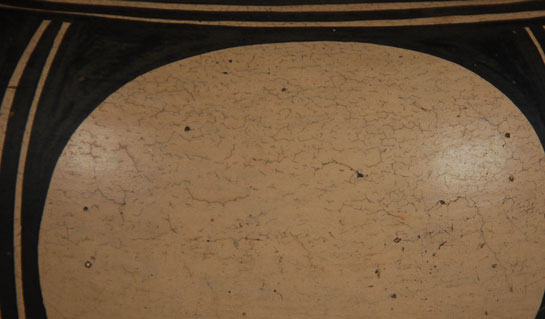Kewa Pueblo Polychrome Aguilar Black-on-cream Jar [SOLD]
+ Add to my watchlist Forward to Friend
- Category: Historic
- Origin: KEWA, Santo Domingo Pueblo
- Medium: clay, pigment
- Size: 10-1/2” tall x 10-1/4” diameter
- Item # C3298B SOLD
Pottery offers a smooth surface on which a curved line can be freely drawn, a wide choice of vessel shapes, and a form and surface completed before the ornamentation is applied, instead of an unfinished object into which the design has to be worked while it is still in the making, as in basketry or textiles.
Eyeing a finished ceramic vessel, a potter must create in her mind the design she conceives as best for that vessel. In so doing, she must be accurate in her assessment, because once a stroke of the brush has laid on some paint; it cannot be erased, removed or changed.
The Aguilar sisters were very adept at designing their jars. They were master potters and painters long before collectors were ready for something as creative and out of the norm as their works. They departed from traditional Santo Domingo designs and created designs of their own. Tourists, because of its departure from tradition, did not immediately accept their work. The casual tourist was familiar with the cheap curios and was happy to go home with some knickknack as a souvenir and proudly display it as a "genuine Indian" article.
This jar is an excellent example of their fine work. It was among the finest being produced at Santo Domingo in the late 1800s and very early 1900s. Their handling of the design style, their precision with paints, and the overall geometries of the layout are far beyond the typical products of that time. The cream slip used at Santo Domingo during this period of a hundred years ago has now mellowed to a beautiful ivory color. The jar exudes a warmth not present when first made. The Aguilar sisters would be pleased to know how much their pottery is appreciated today, something they did not witness during their lifetime.
Condition: very good condition
Provenance: from a gentleman in Colorado
Recommended Reading: Pueblo Pottery of the New Mexico Indians: Ever Constant, Ever Changing by Betty Toulouse

- Category: Historic
- Origin: KEWA, Santo Domingo Pueblo
- Medium: clay, pigment
- Size: 10-1/2” tall x 10-1/4” diameter
- Item # C3298B SOLD



